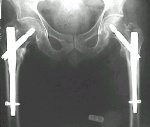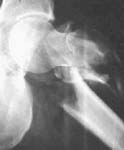
Date: Tue, 26 Mar 2002 19:31:50 EST
Subject: Re: Gamma nail/subtrochanteric fxs
Hello,
Regarding subtrochanteric hip fractures:
1. What are the disadvantages of using a short Gamma nail? At a recent meeting, most traumatologists were using a long nail and none were using the short Gamma nail. It appears that distal nail fractures may be the result of stress risers from the distal locking screw or technical errors. Is a long Gamma unlocked nail satisfactory for subtrochanteric hip fractures:
2. Is the short Trigen nail indicated for subtrochanteric hip fractures: Is the ability to obtain an MRI with the nail insitu really helpful?
3. Can list members submit which implant they prefer for subtrochanteric hip fractures?
Thanks
Mike Messieh
Date: Tue, 26 Mar 2002 21:34:08 -0700
From: Kanlic, Enes M., M.D.
My opinion, based on experience in application of more than 150 cephalomedullary nails:
1. If the fracture does not extend distal to the lesser trochanter more than few mm, short cephalomedullary nails work well.(attachment)
 |
2. The new short nails have better distal targeting jigs, smaller screws, less screws, and if the canal is 2 mm bigger than the nail, "stress fractures" should not happen. Long nails do not necessarily conform to patient anatomy. The distal femur can be penetrated by them and "stress !!??" fractures in supracondylar region can happen as well.
3. Cephalomedullary nail is at least traumatic and biomechanically the best suited device in average surgeon (resident) hands for subtrochanteric femur fractures.(attachment)
 |
 |
Sincerely,
Enes M. Kanlic, M.D., Ph.D.
Associate Professor
Texas Tech University HSC
Orthopaedic Surgery Dept.
El Paso, Texas 79905
Date: Wed, 27 Mar 2002 16:54:59 +0100
From: Josep M. Muoz Vives
I see no advantage (neither controlled randomized prospective studies) of cephalomedullary nail over hip-sliding-screw in sense of blood replacement or mechanical complications... in pertrochanteric and short subtrochantheric fractures. Till now, at least in Spain, a hip sliding screw is much cheaper than a nail.
To me, the main advantage of cephalomedullary nails is in long subtrochantheric fractures when you avoid all the periosteal stripping.
Dr. Josep M. Munoz-Vives
Orthopedic Surgery Dept.
Hospital Dr. Josep Trueta
Girona - Catalunya
Spain
Date: Wed, 27 Mar 2002 11:20:45 -0500
From: William Obremsky
The main advantages of a cephalomedullary nail over a sliding hip screw in patients w/ unstable IT fxs are decreased limb shortening due to less sliding and improved walking as reported by D Hardy JBJS 80A:618, 1998. No differences in OR and blood loss have been seen in several reviews.
I would agree that it is a good implant for reverse oblique fxs and high sub troch fxs.
Bill Obremskey
Date: Wed, 27 Mar 2002 12:40:11 -0500
From: Kevin Pugh
I agree that the literature shows no advantage in terms of blood loss, but this finding surprises me. We switched to nailing peri-trochanteric femur fractures in the elderly poipulation about 1 year ago. The thing that pushed us to do so was not the mechanical properties of the sliding hip screw (nails are better for reverse obliquity), but the decrease in OR time and the decrease in blood loss. For the average patient, this is a percutaneous procedure. The time to open and close is greatly decreased, and that slow drip drip of blood into the drapes is eliminated. I realize that this is from the Journal of Anecdotal Medicine, but in our hands the findings seem to be real.
kp
Kevin J. Pugh, MD
Chief, Division of Trauma
The Ohio State University
Columbus, OH 43210
Date: Wed, 27 Mar 2002 8:00 PM
From: Bill Burman
According to Mike Baumgaertner's defense of the gamma nail in the 1999 OTA Specialty Day debate with Jim Kellam
Hardy's paper reported a 38% reduction in blood loss (relative to the compression hip screw) and Mike's study saw a 44% reduction in blood loss (relative to the compression hip screw).
With respect to subtrochanteric fxs (to which the original post was addressed), Mike said that Ratanen had 9 shaft fracture complications related to 50 short gammas and no shaft fracture complications using 37 longer IM hip screws.
For a general discussion of of cephalomedullary nailing options for subtrochanteric fractures see Toney Russell's OTA Basic Fracture Course Lecture.
Bill Burman, MD
HWB Foundation
Date: Wed, 27 Mar 2002 23:04:49 EST
From: Tadabq
THIS month's JBJS Am has a prospective randomized comparison of plate and nail for "reverse obliquity" fractures (OTA type 31A3) demonstrating shorter operative time, fewer blood transfusions, shorter hospital stays, fewer complications with nails. 7/19 plated had implant failure or nonunion compared to 1/20 for nail.
Tom DeCoster
Date: Thu, 28 Mar 2002 07:41:21 -0500
From: Kevin Pugh
I have been very happy with nails for these fractures in the elderly. Blood loss and OR time are less, wounds are smaller. For intertrochanteric injuries, I use a short nail...generally unlocked, and for peritrochanteric fractures I go long and statically locked. Either way, they are WBAT on the first day. My concern for younger patients is the amount of bone that is removed in the intertrochanteric region in order to get the nail implanted. In the younger population, I have still been using a reconstruction nail for the peritrochanteric fracture because of this concern. Does anybody have experience, positive or negative, with the younger patient?
kp
Date: Thu, 28 Mar 2002 08:54:20 EST
From: MMessieh@aol.com
I find the cephalomedullary nails (ex. Gamma) helpful in obese patients. Even the proximal trochanteric percutaneous incision can be quite deep in obese patients. Think of the incision for a DHS pin and plate! Has obesity be assessed as a binary outcome (failure/nonfailure) in a regression analysis for implant failure for unstable intertrochanteric/subtrochanteric hip fractures? Since Americans are becoming more obese, I am afraid my rate of cephalomedullary nails will also rise.
Date: Thu, 28 Mar 2002 11:54:15 -0500
From: William Obremsky
I have used the IMHS in young patients w/ subtroch and pertroch fxs (as well as for elderly IT fxs)for 4 years. I have been concerned not about the bone loss, but about the injury to the gluteus insertion. Paul Tornetta presented a cadaveric study that indicated that approximately 30% of the gluteus insertion is disrupted. These pts limp for 4-6 months, but hip function appears to return.
French and Tornetta CORR 348:95 1998 reviewed 47 pts w/ ST fxs treated w/ cephalomedullary nails and all healed w/ the most common complication being varus reduction (about 15%). I think it works great, but you need to be careful about starting point and reduction. It is sometime necessary to open at the fx site to clamp or hold the flexed, abducted and externally rotated proximal piece reduced.
Bill Obremskey
Date: Thu, 28 Mar 2002 09:56:23 -0800
From: Chip Routt
Traction films and a detailed preoperative plan/drawing really diminish associated problems through anticipation.
A well planned and performed 95 degree angled blade plate remains a true workhorse for the PER-trochanteric (and even certain SUB-trochanteric) femoral fractures.
A review of Mast/Jakob/Ganz's book "Planning and Reduction Technique in Fracture Surgery" is always recommended.
If you are concerned regarding operative blood losses during open reduction (for nailing or other implant), proper isolation draping allows a cell salvage system.
Chip
M.L. Chip Routt, Jr.,M.D.
Professor-Orthopedic Surgery
Harborview Medical Center
Seattle, WA 98104-2499
Date: Fri, 29 Mar 2002 13:44:15 +0530
From: Dr.R.SACHIDANANDAN
For subtrochanteric fractures, tranverse or short oblique, a Dynamic Condylar Screw with a side plate (95 degree) has given satisfactory results in our institution. The lag screw gets a good purchase in the inferior half of the femoral head and one screws goes all the way into the calcar. The situation is different in a spiral or long oblique fracture where a long gamma nail is the implant of choice.
Regards,
Dr.R.Sachidanandan
Sree Sudheendra Medical Mission Hospital
Cochin,INDIA.
Date: Mon, 01 Apr 2002 09:48:29 -0600
From: Adam Starr
We're doing a prospective randomized trial comparing recon nail vs. long gamma in the tx of subtroch, intertroch and ipsi neck/shaft fxs in young (<50 year old) high energy patients.
The troch entry IM devices like the gamma and IMHS are straightforward in the elderly population. But the younger trauma patient is a different problem. I don't know if the troch entry really offers any benefit with regards to time, incision length blood loss, etc. Also, who knows if the troch entry really affects abductor strength more or less than a piriformis entry?
A study that would be helpful would be one similar to the current JBJS article that Tom Decoster mentioned (on DCS vs IM device) only carried out in a young, high energy population.
We prefer nails for such injuries here, so we might not be the best guys to study the use of the DCS for these kind of fractures.
But it would be a good thing to study. Really, I think most people fall into either the nailing camp, or the plating camp.
Those who prefer nails will probably notice little if any difference between a troch entry device (like the IMHS or the gamma) and a piriformis entry device. If there IS any difference, I hope our study will show it.
Similarly, those who prefer plates will probably be happy with either a DCS or a blade plate.
But, if you compare, say, a DCS to a long gamma nail in the treatment of subtroch fractures in young patients, which will have lower blood loss, higher union rate, better outcome?...I don't think anybody knows.
Adam Starr
Dallas, Texas